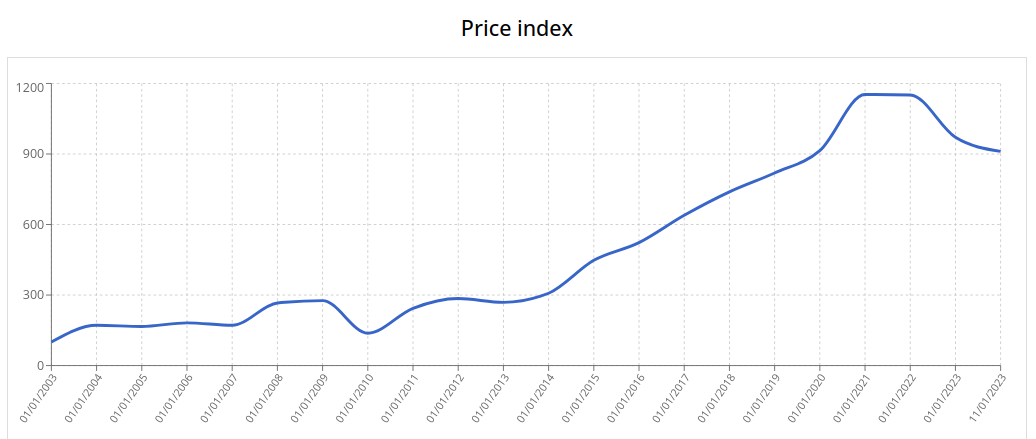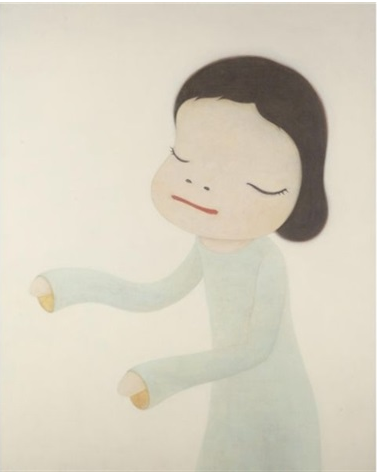Yoshitomo Nara, Asia’s most expensive Contemporary artist
[19/12/2023]A leading figure in Japanese creation, Yoshitomo Nara has established himself in collections around the world with, as his only subject, a little girl with big eyes.
Yoshitomo Nara became a famous artist with a single emblematic subject: an immediately recognizable child with stylized features, presented against a neutral background. His drawings are considered to be at the heart of the Superflat style, a term invented by Takashi Murakami in 2001, and which launched one of the most dynamic postmodern artistic movements. The Superflat aesthetic draws inspiration from the ancient ukiyo-e woodblock prints from the Edo period as well as from the ‘manga’ culture that has conquered Japan since the end of World War II. Obsessed with flatness and two-dimensionality, this art movement has helped to put Contemporary Japanese art on the global art map and has allowed Yoshitomo Nara to emerge as one of the most highly regarded artists on the planet.
Born in 1959 and raised in Hirosaki, a remote town in Aomori, northern Japan, Yoshitomo NARA spent a solitary childhood in the countryside, surrounded by vast fields. Between busy parents and two much older brothers, he kept himself occupied by listening to music, playing with the neighbors’ dogs and doodling in sketchbooks. He moved to Tokyo as a teenager, then to Nagakute at the age of 21 to study art at Aichi University, before leaving Japan for Germany in 1988. He then continued his artistic training at the Staatliche Kunstakademie in Düsseldorf for six years, under the mentorship of A.R. Penck, who was then settled in Cologne, before returning to Japan in 2000. In the mid-1990s, he occasionally exhibited his works in Nagoya and Tokyo where his reputation began to grow quickly.
His paintings from this period feature thick black outlines, stark colors and deliberately naive or crude lines reminiscent of sketches found in manga. However, they already reveal certain signs of his artistic maturity. Profound stylistic changes occurred as of 2000, coinciding with the artist’s return to his native country. Nara first moved towards large-format canvases to create full-length portraits on a vibrant pearly background, refined but without appearing so. By further refining the proportions and features of the little girls, he managed to give them a more captivating enigmatic aura. The child goes beyond the pretext of a “cute” subject to become the vehicle of a subversive allegory.
Nara’s price index at auction (copyright Artprice.com)

Not so cute…
Kawaii is not just an adjective that translates as “Cute”. It is a true Japanese obsession which, since its appearance around fifty years ago, has penetrated all layers of Japanese culture, including official events that, a priori, require the greatest seriousness. The expression of a somewhat pathetic Peter Pan syndrome, particularly for Westerners born before the 1980s, this Kawaii aesthetic is, for the Japanese, a cultivated immaturity aimed at counterbalancing the rigidity and extremely heavy pressures exerted on them by school, family and then business so that they succeed at all costs. It is therefore, initially, a form of protest, expressed by a return to a spirit of childhood. A protest populated by cute little bunnies, lolitas with high socks and giant mascots to cuddle. It promotes a kindness, a vulnerability and an innocence that are intended to be touching, but which Nara likes to subvert in subtle and not so subtle ways.
Beneath the stylistic sentimentality of the children painted by Nara, there is indeed something ‘not quite right’ … a rebellious energy, a tension towards conflict. The chubby little girls with sullen faces sometimes give sidelong glances, filled with suppressed anger. They could fight against someone stronger than them, especially since they occasionally hide a weapon behind their backs. These children express less the paradise of carefree innocence than the awareness of danger in a social world under high pressure.
It is indeed one of Nara’s key strengths, underpinning his singularity and notoriety: recasting the most popular traditional and contemporary Japanese artforms while expressing the ambiguous feelings of an often alienated youth. Another strength is his ability to seduce and satisfy any type of collector, from influential billionaires to young pop culture enthusiasts with minimal budgets.

Yoshimoto Nara, Night Walker
Reception on the art market
Yoshitomo Nara’s meteoric rise on the global art auction market is emblematic of the rapid transformations of the Contemporary art market over a generation. Absent from the radar in 2000, he obtained his first 7-digit result in New York in 2007 for a little tightrope walker (Night Walker, 2001) which fetched almost a million more in 2014 at Sotheby’s Hong Kong. But Nara’s prices and international popularity really exploded in 2015, the year his work generated no less than nine 7-digit results, which helped him to climb into the world’s 100 top-selling artists at auction. But, his rise was not yet over.
In October 2019, the year he turned 60, Nara dwarfed his previous auction record during a Contemporary Art sale organized by Sotheby’s in Hong Kong. From $4.4 million (for his Sleepless Night (Cat)), his auction record rocketed to nearly $25 million for an imposing canvas (234 x 208 cm) dated 2000, the year of the artist’s return to Japan after 12 years in Germany. The little girl in the painting, who hides a weapon behind her back (as the title Knife Behind Back clearly indicates), sold at a higher price than the best works by Takashi MURAKAMI. This represented a veritable reversal: Nara subsequently established himself as the easy-going ‘favorite’ Contemporary artist of major international collectors. Today, he ranks as the 20e most successful artist in the auction world (December 1st, all periods of creation combined) and the second top-selling Contemporary artist behind the ‘eternal’ leader, Jean-Michel Basquiat.
Geographical distribution of Yoshimoto Nara’sturnover at auctions (copyright Artprice.com)

The world of Yoshitomo Nara cannot, however, be reduced to a niche reserved uniquely for wealthy collectors. The artist has followed a path opened by his compatriot Takashi Murakami and by Andy Warhol before him, that involves presenting his work in a wide variety of formats and editions including ‘derivative products’. In addition to highly valued paintings and sculptures, he produces fluffy-toy animals, ceramics, lighting, lithographs, small figurines in editions of several thousand, skateboards, ashtrays, alarm clocks and even first-aid kits, often edited in partnership with the American companies Cerealart Multiples and Artware. He has therefore followed the economic model initiated by Takashi Murakami who, by creating his company Kaikai Kiki Co. more than 20 years ago, largely contributed to blurring the boundaries between fine art and commercial art. The marketing of their creative works into objects for all budgets that are accessible to audiences right across the socio-economic spectrum has allowed Japanese Neo-Pop to infiltrate all areas of consumer culture and to become a truly international phenomenon. This is how Nara, an artist with over a hundred auction results above the million-dollar threshold to his name, is also affordable for just a few hundred dollars. Care should however be taken, because the spirit of collecting can sometimes ignite the prices of even the smallest things: one of his beach towels reached $2,656 this summer in London…
Artmarket article published in our partner magazine Gestion de Fortunes




 0
0
